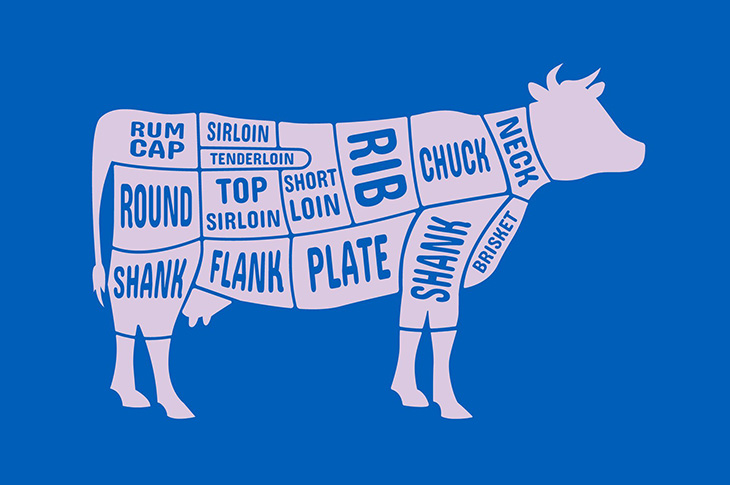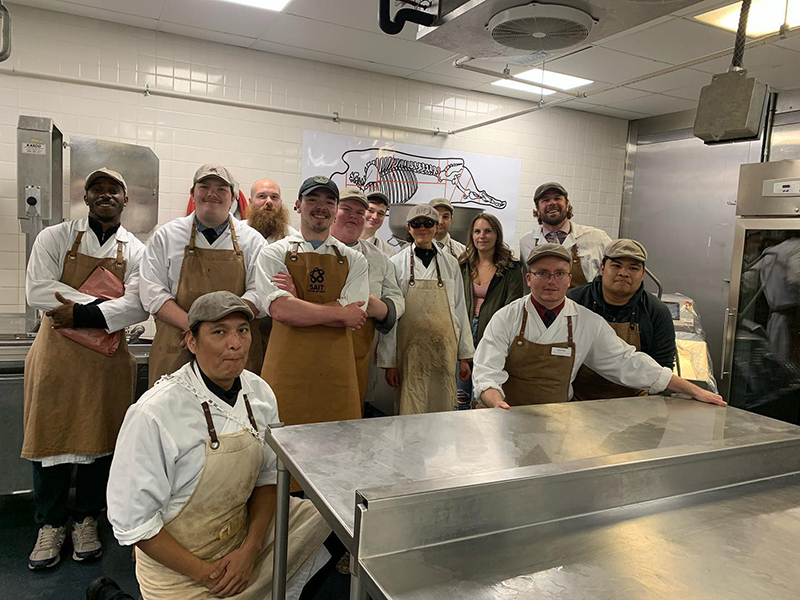Making the cut: A meaty career path waits for graduates of Butchery and Charcuterie Management

Ask Leigh Johnson what he wanted to be growing up and he’ll remember he once held dreams of being a paleontologist or history teacher, but nothing was ever set in stone.
Belle Gauthier, on the other hand, always had one goal: become a veterinarian.
Butchery doesn’t exactly sound like the natural evolution of any of those dreams or goals, so what made Leigh and Belle think, “I want to be a butcher” and apply to the Butchery & Charcuterie Management program #HereAtSAIT?
Pull up a cheese board and break out your good salami — because they’re going to tell us.
This interview has been edited for length and clarity.
What led you to butchery?
Leigh: It took me a while, but I figured out I like working with my hands — it just seems rewarding. Eventually, it was between woodworking, maybe furniture making, cabinetry or food. And I landed on butchery.
I think it’s important for people to know where their food comes from, and I really want a focus of my career to be relationships with ranchers and farmers, to connect with how food is raised.
Belle: I live on a beef and bison ranch in northern Alberta. I wanted to be a veterinarian, so I originally started a Bachelor of Science. Then I rolled into nursing and realized it just wasn’t really for me. What I really wanted to be was a farmer.
I’m really into sustainable farming practices and learning as much as I can about that. I want to open a farm-to-table store, selling people a higher quality meat product at a fair price.
What’s one big thing you took away from the program?
Belle: How to get value out of your products and get the most out of an animal. You can break down the animal in a variety of different ways. Now when I look at an animal, where I look shifts to the top line and back ends, because that’s where the higher quality meats will be.
We also learned about animal feed. I’m interested in selling bison and beef raised on pasture and finished on pasture. Pasture-raising is when the animal is born on grass and they finish on grass — not to say a feedlot is bad. Grass finish is a slower finish, and you won’t end up with the same fat finish you might find with a feedlot animal. I personally really liked the theory, because I’m super into that feed efficiency and how we grow and create an animal that can produce the best that it possibly can.
Leigh: A feedlot is a faster return on your investment, but it can cause higher stress on the animal, because they’re in a smaller contained area. I learned a lot about animal husbandry and had tons of fun in the practical labs. You’re always busy, always doing something.
Animal husbandry
What makes a butcher good at what they do?
Leigh: Organization is number one. You need to plan what you’re doing before you start cutting or you’ll just make a mess. The first time I cut into a beef carcass in class, I cut into the tenderloin, which is the single most expensive thing I could have cut into.
Belle: Butchers are incredibly smart. You have to know the anatomy of an animal or you could be off by a bone and screw up a $50 steak. You really have to be accurate with your cutting to make the most of an animal. And cleanliness is huge.
What’s it like working in SAIT’s Butchery?
Belle: Every Thursday, we get hands-on experience in SAIT’s Butchery, a living classroom. We rotate running the till, wrapping and scaling for customers. We might be in the back doing custom orders as they come up. We can do lots of custom cutting and value-added products, so I think people really appreciate it.
Leigh: It’s a little bit of chaos, but it’s good fun.

What would you say to someone who’s considering the program?
Leigh: I would go for it — there’s so much demand for the skill right now.
Favourite cut of meat?
Belle: That’s too tough a question to ask a butcher.
Leigh: I’m a sucker for Ossobuco. It’s a shank that’s cut into a round and slow braised. Super delicious.
Butchery and Charcuterie Management
Whether it’s working directly with customers or becoming a meat inspector, fill a strong demand in butchery-related roles by learning specialized skills in meat cutting and charcuterie.
Learn moreSkills for the Future
We prepare students for successful careers and lives.
SAIT'S
2020-2025
Strategic plan

Oki, Âba wathtech, Danit'ada, Tawnshi, Hello.
SAIT is located on the traditional territories of the Niitsitapi (Blackfoot) and the people of Treaty 7 which includes the Siksika, the Piikani, the Kainai, the Tsuut’ina and the Îyârhe Nakoda of Bearspaw, Chiniki and Goodstoney.
We are situated in an area the Blackfoot tribes traditionally called Moh’kinsstis, where the Bow River meets the Elbow River. We now call it the city of Calgary, which is also home to the Métis Nation of Alberta.